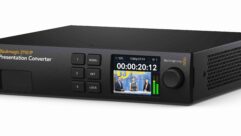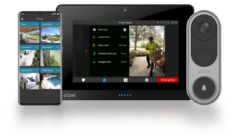Keep it Simple
Oct 1, 2000 12:00 PM,
Gordon Moore
Because the average bartender or restaurant manager has neither the time nor patience to become an audio expert; installing an automatic mic mixer will make his job that much easier.
It used to be that a bar or restaurant had fairly simple audio requirements. A bar would have a television stuck in a corner facing the bar showing the local station. The restaurant would have music playing softly in the background. Control systems were basically just volume up or down right at the television or the stereo amp.
With the advent of increasingly sophisticated customers who have come to expect higher quality audio and more extensive entertainment options, however, the day for these simple systems has passed. Now, an eating establishment or bar must cater to customers who want to hear more, see more and expect more from the A-V system than ever before.
Unfortunately, most bars, restaurants and hotels cannot hire an A-V engineer to run things. The operator is still the aspiring actor, the new arrival to the job market or the night owl who would rather tend bar than anything else. Audio experts they are not, and with the new heightened demand for service, they are also not available to run or make changes to the sound system. Give them access to a full rack of pro audio gear – mixers, EQs or compressors – and you will have a mess on your hands in no time.
Enter the modern control system. Simple analog control panels or touchpanels can make system control and setup even easier, but with their sophistication, it becomes tempting to make them complex. Complexity is the last thing you want to hand a bus boy. So, when configuring control systems for a bar, restaurant or hotel keep the perspective of keeping the controls simple.
Simplified controlThere is digital control, and there is analog control. Digital control systems use a central processor in the form of either a touchpanel or a computer that communicates with the equipment in the rack. RS-232, RS-422, FireWire, USB and manufacturer-based protocols may be involved. The control system may have outboard interfaces, contact closures, IR (infrared) ports and on-board VCAs. For A-V equipment designed with direct control capabilities via serial commands, these control systems can exert direct control. The commands available in a unit can be widely varied depending on design. Input gain, fader, equalization, memory presets, feedback control, output gain, compression, limiting and signal routing may all be available. For components that do not have direct digital control protocols, there are often IR remote controls that can be emulated by the control system. For standard design devices, these control systems often offer in-line volume controls that can be placed in the audio pathway.
The advantage to digital control methods lies in the ability to deal with conditional situations. Much like an automobile that automatically disengages cruise control when the brakes are applied, conditional controls prevent errors. For example, if the video projector is lowered, the system can be programmed to turn off the background music, lower the screen, change the EQ curve and lower the house lights in the front of the room automatically. At the same time, it could double check to make certain that the dividing wall is opened and stop all of the above.
An additional benefit is the lack of direct intervention in the audio path. The control system only controls the audio gear; it does not become a part of the audio pathway. None of the control cabling will introduce noise, hum, anomalies or distortion if properly designed and installed.
Analog controls involve such standard electrical devices as potentiometers (linear and audio tapes), momentary contact closure (buttons), latching buttons, reed switches and ramped voltage generators. Pots have long been placed in-line for level control of audio signals (variable H and L-pads). Their disadvantage is that they lie directly in the audio flow. As such, they add more connections to the audio path and can adversely affect the audio due to poor design or improper usage. They will add wiring and connections, which can affect the audio passing through them. Anyone who has attempted to add a mute switch to the audio line of a phantom-powered mic can tell you the pop associated with it can be horrendous. Use of a non-polar capacitor and resistor can ease that pop.
So, another analog method of level control lies in VCAs (voltage controlled amp). The pots and ramped voltage generators are used for VCA control. VCAs are excellent audio control devices because they allow adjustment of audio levels via a change in voltage to an op-amp. Changing the DC voltage to the VCA controls the amount of attenuation placed on the audio signal passing through the VCA. The advantage lies in a VCA’s indirect control of the audio signal. By varying the amount of control voltage being supplied to the VCA, the level can be changed without direct intervention in the audio path. The control cabling from the linear pot to the VCA can be simple small-gauge wiring, and the concern for induced interference can be eliminated. Voltage ramp generators, instead of linear pots, can also control VCAs. VCAs can be found in many products directly built in or can be added as an external dedicated device.
Controls to lock upWhat happens in the control system behind the panel can be incredibly sophisticated, but there are certain controls that are best kept out of the hands of the staff. EQs should be securely locked away. There are far too many people who think a happy face is the right thing to do with graphic EQs. After a room has been properly equalized, lock up the front panel. An EQ is the audio equivalent of a thermostat; nobody really knows where to set it, and nobody can keep his or her hands off of it. Therefore, lock it up and throw away the key (figuratively speaking). The same cautions apply to limiters and compressors.
If there are mics in the system, the temptation is to set up individual gain controls on these mics. Doing so offers some serious negative repercussions. First, if they are changing input trim, they are affecting your S/N ratio. The input trim of the mic should be optimized by the installer and then locked away far from the staff. If you must have individual channel control, give them access to the fader (or its equivalent) where they can adjust the contribution to the mix but not the input trim.
Watch out for program source input control as well. The bus boy is not likely to recognize clipped audio from an overdriven input, and clipped audio, even if attenuated downstream from the clipping input, is going to damage loudspeakers. CDs, DVD players and digital satellite receiver systems can have wildly varying levels. Calibrating the system with a known level source, such as a test CD, can help prevent over driven program audio. The system will need some sort of level control to accommodate variances between tapes or CDs. That range can be limited.
Within limitsWith many of today’s mixers, or through the programming of the control system, you can place limits on the amount of change that the end user can place on a channel. First, be aware of your headroom – the amount of additional level you can turn up the system from optimum before hitting feedback. If the headroom is 12 dB SPL, then do not let the bartender turn up the inputs any more than 6 dB. That way, he cannot feed the room into feedback. Design the control system so he can only turn it up a bit (3 dB to 6dB) and down only as far as needed. Avoid letting him turn it all the way down; that leads to unwanted service calls. This sort of control can be achieved with either digital or analog (VCA) control. The programming should allow only X amount of travel on the level. If you are using 10K linear pots for VCA control, then placing a resistor in parallel across wiper/CCW or wiper/CW (depending on product requirements) can also limit range. Volume control on the outputs is also a problem. The same rules should apply as used on input levels; allow only a limited amount of control.
Use those presetsWhat about situations where the room may be used for different purposes? Let’s look at an example. The sports bar and restaurant has three seating areas. The main bar has a large screen projection system with a surround sound system. Monday is game night with a loyal crowd of fans. Tuesday through Thursday is after hours for the local business people to wind down and do a little business. Friday is live band night, and Saturday is DJ night. The sound system could use a special EQ curve applied specifically to each use. Using a DSP-based EQ here makes great sense. Most (if not all) have presets available where you can program in a variety of response curves, each tailored to a special use. Then, via your control system, the bar manager can just push the button (analog or touch panel) associated with that function. Presets are available on many mixers, signal routers and DSP boxes.
Another advantage to using presets is the reduction in programming. For example, for sports night, the system will have EQ curve #1 used in the main bar area. Audio from the receiver will be routed into the surround sound system. The background system will only feed the room in the back where the stamp collectors are meeting. The level in the bar will be jacked up so the game viewers can be part of the stadium crowd, and the lights need to be dimmed near the screen but higher in the back area. Instead of the bartender having to remember all those details, the touchpanel could have a button that says sports night. Push that button, and everything gets set up. Programming all the changes that may be needed in the audio gear may be extensive and expensive. Utilizing presets keeps the program simpler. Let’s examine this system in both the analog and the digital control world.
Analog done the wrong wayIn the first panel, the controls consist of a series of volume controls that are directly in line on the audio circuitry. Additionally, the selection of program audio is made by pushing one of a series of latching buttons for each room – bar, dining and banquet. Not shown but in the rack is a much-ignored chart taped to the rack showing how to set up the EQ. The EQ, amp and routing switcher are all accessible to the staff.
The possibility for error and the probability of additional noise on the system are high. In-line audio controls mean additional audio quality wiring is required, increasing the possibility of RF or EMI problems, and the cooks could actually end up having the game they wanted to listen to in the banquet room, which, in turn, could end up in the dining hall on mom’s night out. They might even end up with two audio choices going to the bar. The lack of status lights and easy accessibility spells trouble in the near future. Although this sort of panel seems awfully antiquated, there are lots of systems out there designed in a similar fashion.
In the second panel, the setup is simplified and easier for the staff to use. This is accomplished by using presets in the system, VCA controls and removing unneeded options. In addition, the panel makes sense in the format of usage. The volume controls are 10K linear pots controlling DC voltage to VCAs. The buttons are momentary contacts that trigger presets in the audio equipment. Mistakes cannot be made here, and the system is limited to the correct applications. Only certain choices are available, and the staff cannot route two sources to the same room at the same time. Need security even for this panel? Lock it behind a locking door or use a multi-pole key switch to lift the ground on all the analog control cables. If they cannot complete the circuit, then they cannot change the system. Be careful here; if you break the circuit of the VCAs, the unit they control might jump to either full volume or completely off, depending on the VCA design.
Digital panelsIn this case, a touchpanel-based system is installed. All the functions could also be duplicated in a PC-based system. Password protection can help here; let only trained managers make certain changes, such as volume. Touchpanel programmable systems offer the security advantage over PC-based systems. A PC-based system can be a big temptation for the hacker, while a programmable control system is not as easily breached.
Another advantage to touchpanel-based controls is the separation of function. Using a hierarchy of screens allows the system to keep the bus boy on track. When changing the volume for the CD player, show only a page with CD controls. When setting up room combining, have a page programmed only with the room combining option. In that manner, the end user cannot accidentally choose a control for a different device.
As mentioned earlier, conditional controls can be helpful in a programmable control system. For example, when in room-combining mode, the system can verify that the walls are opened. If they are closed, a reminder to open them could be programmed into the screen. Until the walls are moved, the operator will be unable to change the system to combined mode. This can also prevent damage to mechanical systems such as drop-down projector mounts.
When in DJ mode, the system could be configured to make certain that only the audio input jack where the DJ has plugged his cart is on-line. The television will be off, and the audio from satellite will be shut down.
Other control possibilitiesDo not forget that some manufacturers offer volume monitor systems that measure the level in the room and raise the sound system to compensate as sort of an acoustical thermostat. As the bar gets more crowded, the system will automatically raise in level. Keep in mind the psychoacoustics of this type of function. The crowd gets loud, so the volume goes up. Because the volume is higher, the crowd gets louder, which then brings up the volume. You get the picture; if people are gathered to socialize, then they will talk regardless of the source. Be sure to set limits on what that auto leveling box will do to prevent driving the system into illegal, hearing-damaging levels, feedback, clipping or worse.
The key point in all control systems for bars, restaurants and smaller hotels is remembering that the operator will not necessarily be knowledgeable or trained in running an A-V system. The interface, whether an analog-based control panel or a digitally based touch panel type system, must be configured so that even a novice can set up a room without damaging gear or the clientele’s hearing. This may involve taking the role of guide or consultant with the owner to help him avoid excess complexity. Sometimes, the owner of the system will want all possibilities open to him when, in fact, he will only need a few options. Just because a system can be configured in 327 different ways does not mean it should be. Follow the keep-it-simple principle.










